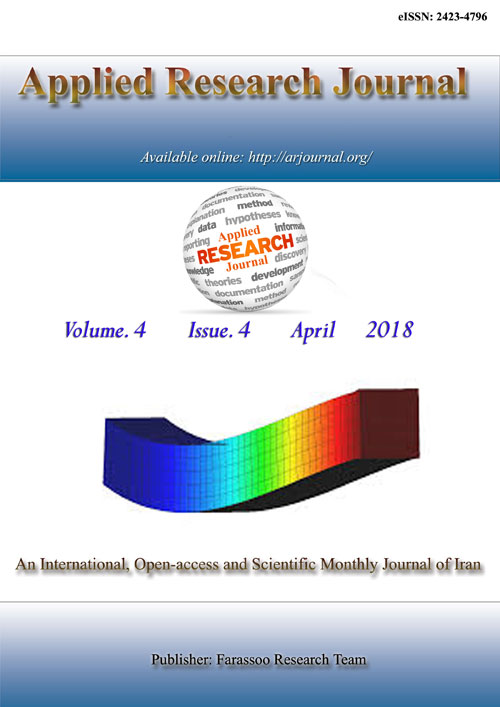فهرست مطالب
Applied Research Journal
Volume:2 Issue: 8, Aug 2016
- تاریخ انتشار: 1395/06/16
- تعداد عناوین: 4
-
Pages 336-343A procedure for modifying an existing model that resembles a two dimensional moment resisting frame of a building for its dynamic behavior to develop a one dimensional stick model is presented. The procedure is assumed to be applicable for both time domain and response spectrum analysis for earthquake base excitation such as (El_Centro) that acts on the original 2D frame of the building. The modified stick model is assumed to compose of an assemblage of a series of two node cantilever beams having two degrees of freedom per node, the rotational degree of freedom at each node is further condensed at element level resulting in a new stiffness and mass matrices taking into account the effects of those rotations. Different correction factors are implemented for the exterior and interior columns in addition to the number of floors of the original 2-dimensional frame of the building in each direction. The developed procedure is then implemented in time domain and response spectrum analysis using a computer program especially coded and written for the purpose of the study on the basis of MTAB. For each case study of multi-story building, the natural time period and the resulting base shear and drifts which are predicted by the proposed stick model are evaluated and compared with other existing modeling techniques. Though a good agreement of the natural time periods of the building frames between the proposed modeling technique and other methods was found but, the responses were found to be in general- higher than those of the conventional 2D frame. While, the drifts as expected by the stick model seem to be lower than those of the conventional 2D frame modeling techniques (the finite element based on SAP2000).Keywords: Multi, story, time domain analysis, response spectrum analysis, natural time period, base shear
-
Pages 344-352The main goal of this study is to evaluate cold mixtures incorporating various percentages of reclaimed asphalt pavements (RAP) which is a typical sustainability technique to enhance the modern flexible pavement technology. The physical properties of RAP materials, new emulsion asphalt and new aggregate have been tested to evaluate the characteristics of these materials. Two mix design methods have been developed for control cold mix without RAP and recycled cold mixes containing 25 to 90 % of RAP by weight of total aggregate. First mix design depended indirect tensile strength as an indicative measure to determine optimum emulsion asphalt content while the second mix design method used Asphalt institute method (MS-14 and MS-21) . It found that Asphalt institute method required higher percent of optimum asphalt content than ITS method. The test results indicated that the recycled cold mixes containing high percent of RAP (75 to 90 %) are superior to control cold mix in traffic loading resistance and moisture susceptibility.Keywords: Physicochemical Characteristics, Heavy Metals, Ions, Soil, Vegetables, Kwaya, Kusar, Borno State
-
Pages 353-361The objective of this study was to investigate the effect of P-Delta analysis on the static and dynamic stability analysis of high rise steel buildings subjected to earthquake excitation. Different building models including ten, twenty, thirty, forty and fifty story composite steel buildings with symmetrical and asymmetrical layouts were analyzed. Finite element approach by using ETABS software was used to conduct this study. Different parameters were investigated including number of stories, structural elements stiffness, and bracing system. The "second-order" analysis, which includes geometric nonlinearity and P-Delta effect, used to check the adequacy of the "amplified first-order" analysis proposed by AISC specification for stability and strength design. Second-order analysis with linear and nonlinear time-history, including P-Delta effects was accounted for. The numerical analysis results presented reveal that the stability coefficient approach introduced in the ASCE 7-10 standard to consider P-∆ effects in the design and analysis of structures appears to be overly conservative. A maximum stability coefficient (θmax) greater than 0.25 would be necessary to account for P-Delta effects. This depends on the type of loading, number of stories, type of analysis as static or dynamic and shape of the buildings as symmetrical or asymmetrical.Keywords: Dynamic Analysis, High, Rise Building, Finite Element, P, Delta Effect, Stability
-
Pages 362-369Asphalt concrete is susceptable to cracking under repeated loading and various environmental conditions during its service life. This will impare the serviciability and durability of the pavement layers. Asphalt concrete mixtures can heal by themselves in slow process under repeated loading at ambient temperature. The micro cracks healing phenomena can increase the lifetime of asphalt treated layer for several years. The aim of this work was to investigate the impact of micro crack healing phenomena of asphalt concrete on the resilient characteristics under shear and tensile repeated stresses. Specimens of 100 mm diameter and 75 mm of height have been prepared at optimum asphalt content, and at 0.5% asphalt above and below the optimum. Specimens were devided into two groups, the first group was subjected to repeated indirect tension, while the second group was subjected to repeated punching shear stress. Both testing techniques were conducted using the Pneumatic repeated load system (RPLS) at 25 ° C for 20 minutes at three constant stress levels to allow for the initiation of micro cracks. Specimens were withdrawn from the testing chamber and stored in an oven for 120 minutes at 60 ° C to allow for crack healing. Specimens were subjected to another cycle of repeated tensile or shear stresses at 25 ° C for 20 minutes. Another healing process was conducted on the specimens. The deformation of the specimens under repeated indirect tensile or shear stresses was captured using video camera for both conditions. The impact of crack healing was detected through the variation of the resilient characteristics under three levels of stress application before and after healing.Keywords: Asphalt concrete, resilient modulus, tensile stress, shear stress, Repeated load, Crack healing


